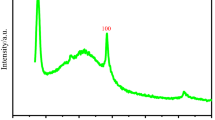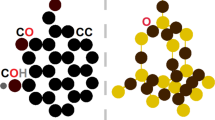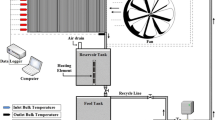Abstract
This study aims to examine the thermal conductivity of reduced Graphene Oxide solid dispersed in the Water fluid. For this mono-nanofluid, thermal conductivity was examined in particular temperatures (25–50 °C) and mass fractions (1–5 mg mL−1). Field emission scanning electron microscope test was done to observe the microstructure of the solid. The results showed the highest thermal conductivity enhancement (31.19%) in 5 mass%–50 °C. A novel correlation including 1.25% utmost deviation was predicted via curve-fitting on the 3D-output to tally the thermal conductivity of the nanofluid. Then, an artificial neural network with R2 = 0.99 was trained. Endmost, rGO/Water has satisfactory heat transfer capacity in thermal industries.















Similar content being viewed by others
References
Choi SUS, et al. Enhancing thermal conductivity of fluids with nanoparticles. No. ANL/MSD/CP-84938; CONF-951135–29. Argonne National Lab., IL (United States) (1995).
Okonkwo EC, et al. An updated review of nanofluids in various heat transfer devices. J Thermal Anal Calorim. 2020. https://doi.org/10.1007/s10973-020-09760-2.
Zheng Y, et al. Potential energy and atomic stability of H2O/CuO nanoparticles flow and heat transfer in non-ideal microchannel via molecular dynamic approach: The Green-Kubo method. J Thermal Anal Calorim. 2020. https://doi.org/10.1007/s10973-020-10054-w.
Afridi MI, et al. Entropy Generation in Cu-Al2O3-H2O Hybrid Nanofluid Flow over a Curved Surface with Thermal Dissipation. Entropy, 2019;21(10): 941. https://doi.org/https://doi.org/10.3390/e21100941
Safaei MR, et al. Thermal analysis of a binary base fluid in pool boiling system of glycol–water alumina nano-suspension. J Thermal Anal Calorim. 2020. https://doi.org/10.1007/s10973-020-09911-5.
Sarafraz MM, et al. Convective bubbly flow of water in an annular pipe: role of total dissolved solids on heat transfer characteristics and bubble formation. Water. 2019;11(8):1566. https://doi.org/10.3390/w11081566.
Martínez-Merino P, et al. The Role of the Interactions at the Tungsten Disulphide Surface in the Stability and Enhanced Thermal Properties of Nanofluids with Application in Solar Thermal Energy. Nanomaterials. 2020;10(5):970. https://doi.org/10.3390/nano10050970.
Alawi OA, et al. Energy efficiency of a flat-plate solar collector using thermally treated graphene-based nanofluids: Experimental study. Nanomater Nanotechnol. 2020;10:1847980420964618. https://doi.org/10.1177/1847980420964618.
Tlili I, et al. Nanotechnology for water purification: electrospun nanofibrous membrane in water and wastewater treatment. J Water Reuse Desalin. 2019a;9(3):232–48. https://doi.org/10.2166/wrd.2019.057.
Tlili I, et al. Water management and desalination in KSA view 2030. J Thermal Anal Calorim. 2020;139(6):3745–56. https://doi.org/10.1007/s10973-019-08700-z.
Lee S et al. Application of metallic nanoparticle suspensions in advanced cooling systems. No. ANL/ET/CP-90558; CONF-961105–20. Argonne National Lab., IL (United States) (1996).
Zhang X, et al. Analysis of hemodynamics and heat transfer of nanoparticle-injected atherosclerotic patient: Considering the drag force and slip between phases of different particle shapes and volume fractions. Int J Thermal Sci. 2020;159:106637. https://doi.org/10.1016/j.ijthermalsci.2020.106637.
Tlili I, et al. Investigation of thermal characteristics of carbon nanotubes: Measurement and dependence. J Mol Liq. 2019b;294:111564. https://doi.org/10.1016/j.molliq.2019.111564.
Chen D, et al. Experimental investigation of viscosity, enhanced thermal conductivity and zeta potential of a TiO2 electrolyte–based nanofluid. Int Commun Heat Mass Transf. 2020;118:104840. https://doi.org/10.1016/j.icheatmasstransfer.2020.104840.
Xu Y, et al. Synthesis and characterization of additive graphene oxide nanoparticles dispersed in water: Experimental and theoretical viscosity prediction of non-Newtonian nanofluid. Math Methods Appl Sci. 2020. https://doi.org/10.1002/mma.6381.
Ansón-Casaos A, et al. The viscosity of dilute carbon nanotube (1D) and graphene oxide (2D) nanofluids. Phys Chem Chem Phys. 2020;22(20):11474–84. https://doi.org/10.1039/D0CP00468E.
Sharma S, et al. Molecular level investigation of curcumin self-assembly induced by trigonelline and nanoparticle formation. Appl Nanosci. 2020;10(11):3987–98. https://doi.org/10.1007/s13204-020-01526-4.
Topal I, et al. Molecular dynamics study of the thermal conductivity in nanofluids. Chem Phys. 2019;516:147–51. https://doi.org/10.1016/j.chemphys.2018.09.001.
Nguyen Q, et al. Discrete ordinates thermal radiation with mixed convection to involve nanoparticles absorption, scattering and dispersion along radiation beams through the nanofluid. J Thermal Anal Calorim. 2020a. https://doi.org/10.1007/s10973-020-10005-5.
Esencan Turkaslan B, et al. Optimizing parameters of graphene derivatives synthesis by modified improved Hummers. Math Methods Appl Sci. 2020. https://doi.org/10.1002/mma.6704.
Alsarraf J, et al. Increase thermal conductivity of aqueous mixture by additives graphene nanoparticles in water via an experimental/numerical study: Synthesise, characterization, conductivity measurement, and neural network modeling. Int Commun Heat Mass Transf. 2020;118:104864. https://doi.org/10.1016/j.icheatmasstransfer.2020.104864.
Liu WI, et al. A novel comprehensive experimental study concerned graphene oxide nanoparticles dispersed in water: Synthesise, characterisation, thermal conductivity measurement and present a new approach of RLSF neural network. Int Commun Heat Mass Transf. 2019;109:104333. https://doi.org/10.1016/j.icheatmasstransfer.2019.104333.
Kazemi I, et al. Improving the thermal conductivity of water by adding mono & hybrid nano-additives containing graphene and silica: A comparative experimental study. Int Commun Heat Mass Transf. 2020;116:104648. https://doi.org/10.1016/j.icheatmasstransfer.2020.104648.
Nguyen Q, et al. A novel correlation to calculate thermal conductivity of aqueous hybrid graphene oxide/silicon dioxide nanofluid: synthesis, characterizations, preparation, and artificial neural network modeling. Arabian J Sci Eng. 2020b. https://doi.org/10.1007/s13369-020-04885-w.
Wang J, et al. Established prediction models of thermal conductivity of hybrid nanofluids based on artificial neural network (ANN) models in waste heat system. Int Commun Heat Mass Transf. 2020;110:104444. https://doi.org/10.1016/j.icheatmasstransfer.2019.104444.
ASHRAE, 2015 Ashrae Handbook HVAC applications. (2015).
Ijam A, et al. A glycerol–water-based nanofluid containing graphene oxide nanosheets. J Mater Sci. 2014. https://doi.org/10.1007/s10853-014-8312-2.
Sen Gupta S, et al. Thermal conductivity enhancement of nanofluids containing graphene nanosheets. J Appl Phys. 2011. https://doi.org/10.1063/1.3650456.
Glory J, et al. Thermal and electrical conductivities of water-based nanofluids prepared with long multiwalled carbon nanotubes. J Appl Phys. 2008. https://doi.org/10.1063/1.2908229.
Assael MJ, et al. Thermal conductivity of suspensions of carbon nanotubes in water. Int J Thermophys. 2004. https://doi.org/10.1023/B:IJOT.0000038494.22494.04.
Hwang YJ, et al. Investigation on characteristics of thermal conductivity enhancement of nanofluids. Curr Appl Phys. 2006. https://doi.org/10.1016/j.cap.2005.07.021.
Das SK, et al. Temperature dependence of thermal conductivity enhancement for nanofluids. J Heat Trans. 2003. https://doi.org/10.1115/1.1571080.
Du C, et al. "Thermal conductivity enhancement of nanofluid by adding multiwalled carbon nanotubes: Characterization and numerical modeling patterns. Math Methods Appl Sci. 2020. https://doi.org/10.1002/mma.6466.
Jha N, et al. Thermal conductivity studies of metal dispersed multiwalled carbon nanotubes in water and ethylene glycol based nanofluids. J Appl Phys. 2009. https://doi.org/10.1063/1.3240307.
Chon CH, et al. Empirical correlation finding the role of temperature and particle size for nanofluid (Al2O3) thermal conductivity enhancement. Appl Phys Lett. 2005. https://doi.org/10.1063/1.2093936.
Acknowledgements
Dr. Tawfeeq Abdullah Alkanhal would like to thank Deanship of Scientific Research at Majmaah University for supporting this work.
Author information
Authors and Affiliations
Corresponding author
Ethics declarations
Conflict of interest
The authors declare that they have no conflict of interest.
Additional information
Publisher's Note
Springer Nature remains neutral with regard to jurisdictional claims in published maps and institutional affiliations.
Rights and permissions
About this article
Cite this article
Alkanhal, T.A. Comprehensive investigation of reduced graphene oxide (rGO) in the base fluid: thermal analysis and ANN modeling. J Therm Anal Calorim 144, 2605–2614 (2021). https://doi.org/10.1007/s10973-020-10433-3
Received:
Accepted:
Published:
Issue Date:
DOI: https://doi.org/10.1007/s10973-020-10433-3




